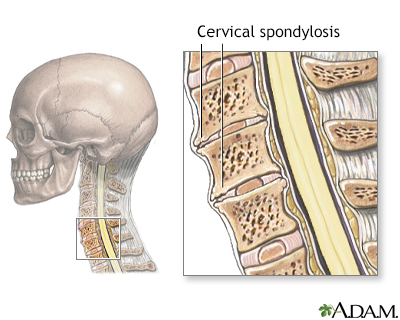Pregnancy SmartSiteTM
Cervical osteoarthritis; Arthritis - neck; Neck arthritis; Chronic neck pain; Degenerative disk disease DefinitionCervical spondylosis is a disorder in which there is wear on the cartilage (disks) and bones and joints of the neck (cervical vertebrae). It is a common cause of chronic neck pain. CausesCervical spondylosis is caused by aging and chronic wear on the cervical spine. This includes the disks or cushions between the neck vertebrae and the joints between the bones of the cervical spine. There may be abnormal growths or spurs on the bones of the spine (vertebrae). Over time, these changes can press down on (compress) one or more of the nerve roots. In advanced cases, the spinal cord becomes involved. This can affect your arms, legs, and balance. Everyday wear and tear may start these changes. People who are very active at work or in sports may be more likely to have them. The major risk factor is aging. By age 60, most people show signs of cervical spondylosis on x-ray. Other factors that can make someone more likely to develop spondylosis are:
SymptomsSymptoms often develop slowly over time. But they may start or get worse suddenly. The pain may be mild, or it can be deep and so severe that you are unable to move. You may feel the pain over the shoulder blade. It may spread to the upper arm, forearm, or fingers (in rare cases). The pain may get worse:
You may also have weakness in certain muscles. Sometimes, you may not notice it until your health care provider examines you. In other cases, you will notice that you have a hard time lifting your arm, squeezing tightly with one of your hands, clumsiness of your hand, or other problems. Other common symptoms are:
Less common symptoms are:
Exams and TestsA physical exam may show that you have trouble moving your head toward your shoulder and rotating your head. Your provider may ask you to bend your head forward and to each side while putting slight downward pressure on the top of your head. Increased pain or numbness during this test is usually a sign that there is pressure on a nerve in your spine. Weakness of your shoulders and arms or loss of feeling can be signs of damage to certain nerve roots or to the spinal cord. A spine or neck x-ray may be done to look for arthritis or other changes in your spine. MRI or CT scans of the neck are done when you have:
Electromyography (EMG) and nerve conduction velocity tests may be done to examine nerve root function. TreatmentYour providers can help you manage your pain so that you can stay active.
A type of talk therapy called cognitive behavioral therapy may be helpful if the pain is having a serious impact on your life. This technique helps you better understand your pain and teaches you how to manage it. Medicines can help your neck pain. Your provider may prescribe nonsteroidal anti-inflammatory medicines (NSAIDs) for long-term pain control. Short-term steroid use can also reduce inflammation and improve symptoms. Opioids may be prescribed if the pain is severe and does not respond to NSAIDs. If the pain does not respond to these treatments, or you have a loss of movement or feeling, surgery is considered. Surgery is done to relieve the pressure on the nerves or spinal cord, and it can involve fusion of part of the neck. Outlook (Prognosis)Most people with cervical spondylosis have some long-term symptoms. Most of these symptoms improve with non-surgical treatment and do not need surgery. Many people with this problem are able to maintain an active life. Some people will have to live with chronic (long-term) pain. Possible ComplicationsThis condition may lead to the following:
When to Contact a Medical ProfessionalContact your provider if:
ReferencesBoody BS, Goldstein ZH, Sasso R. Pathophysiology of cervical spondylosis, radiculopathy, and myelopathy. In: Steinmetz, MP, Berven SH, Benzel EC, eds. Benzel's Spine Surgery. 5th ed. Philadelphia, PA: Elsevier; 2022:chap 29. Fast A, Dudkiewicz I. Cervical degenerative disease. In: Frontera WR, Silver JK, Rizzo TD, Jr., eds. Essentials of Physical Medicine and Rehabilitation. 4th ed. Philadelphia, PA: Elsevier; 2019:chap 3. Ronthal M. Arm and neck pain. In: Jankovic J, Mazziotta JC, Pomeroy SL, Newman NJ, eds. Bradley and Daroff's Neurology in Clinical Practice. 8th ed. Philadelphia, PA: Elsevier; 2022:chap 32. | ||
| ||
Review Date: 6/4/2025 Reviewed By: C. Benjamin Ma, MD, Professor, Chief, Sports Medicine and Shoulder Service, UCSF Department of Orthopaedic Surgery, San Francisco, CA. Also reviewed by David C. Dugdale, MD, Medical Director, Brenda Conaway, Editorial Director, and the A.D.A.M. Editorial team. View References The information provided herein should not be used during any medical emergency or for the diagnosis or treatment of any medical condition. A licensed medical professional should be consulted for diagnosis and treatment of any and all medical conditions. Links to other sites are provided for information only -- they do not constitute endorsements of those other sites. No warranty of any kind, either expressed or implied, is made as to the accuracy, reliability, timeliness, or correctness of any translations made by a third-party service of the information provided herein into any other language. © 1997- A.D.A.M., a business unit of Ebix, Inc. Any duplication or distribution of the information contained herein is strictly prohibited. | ||


 Skeletal spine
Skeletal spine Cervical spondylos...
Cervical spondylos...
